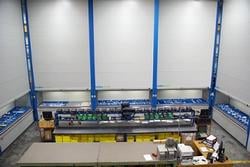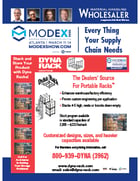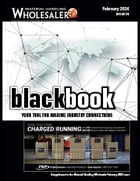
Order fulfillment at Hauni Richmond is smoking fast
Hauni is the world’s leading supplier of manufacturing technology for the international tobacco industry. With corporate locations around the globe, Hauni Richmond supports customers worldwide in the fields of tobacco processing as well as filter and cigarette manufacturing. They offer innovative technologies for all process stages from tobacco processing to the production of filters, cigarettes and special products through to final quality measurements.
The Hauni facility in Richmond, VA focuses specifically on spare parts sales for North America, Canada and Mexico and machine remanufacturing for the world markets. At this facility Hauni specialists completely dismantle and remanufacture machines using state of the art technology with verified, overhauled and new OEM quality components providing customers tried and tested machines that are once again as good as new.
When management needed to reduce the footprint of Richmond’s remanufacturing operations to make room for other revenue generating actives, the stockroom was faced with a 60% reduction in floor space. The stockroom already had a floor to ceiling man up narrow aisle picking system and there was little floor space and no additional shelf space that could be squeezed out.
With over $14 million dollars in parts inventory the stockroom is the heart of the remanufacturing operation. “We couldn’t reduce our quantity of parts on hand without slowing down manufacturing,” said Clarence Cox, Divisional Manager at Hauni Richmond. “We had to find a solution to manage the same number of SKUs in 60% less space.”
A Total Solution
After careful research Hauni Richmond installed 5 Shuttle XP Vertical Lift Modules (VLMs) from Kardex Remstar with FastPic5 inventory management software integrated with SAP and an 18 position batch station. They also incorporated pick to light technologies and label printers to manage the stockroom inventory. “We needed a complete solution and the local Kardex Remstar distributor was the only vendor that could do it all; from the initial cube analysis and equipment installation to providing a logical parts slotting plan and physical parts loading through long term support,” said Cox.
Faster Picking with Less Labor
While order volume and SKU count has remained the same, Hauni Richmond is picking 75% faster with 47% less labor. With an average of 628 picks and 278 puts a day, Hauni Richmond performs over 223,000 transactions per year. “We are absolutely picking orders faster with the Shuttle VLM technology- we’re easily picking the same number of orders in a quarter of the time,” said Cox. The previous manual system required 17 workers and overtime was common. “Previously we were working an average of 3,200 overtime hours a year,” said Cox, “Money spent for overtime hours adds up quick.” The new automated system that requires 9 workers and virtually no overtime, providing a 47% reduction in labor.
Space Savings Exceeded
The original stockroom occupied 9,069 square feet of floor space. The new VLM stockroom and bulk area occupies 3,180 square feet, allowing Hauni Richmond to free up 5,889 square feet of floor space. “We were required to reduce the stockroom footprint by 60%, and we exceed the requirement by reducing our footprint by 65%,” said Cox.
Accuracy That’s Easy To Maintain
“Our accuracy has gone from 97% to 99%, but it requires a lot less effort to maintain it now,” said Cox. Previously, multiple orders were sorted from one box of picked parts and while accuracy was achieved, it was a manual and very time consuming process. When receiving a part into the stockroom, the manual system would require a cycle count of that part within 24 hours to ensure the put location was correct. This was redundant, but necessary to maintain accuracy in the previous system. “With pick to light technology directing replenishment and the VLMs consistently cycle counting our 99% accuracy rate is easy to achieve,” said Cox.
The Manual System
Previously, Hauni Richmond used a 3 aisle man up narrow aisle order picking system and 5 vertical carousels to manage the inventory in the stockroom. Using a paper based manual system the order picker would use a paper pick ticket to drive the order picker to the location of the part. The vertical carousels were managed in a similar manner. The paper pick ticket would tell the order picker which carrier number the part was stored on. The picker would enter the carrier number and the vertical carousel would rotate to the desired carrier for the order picker to retrieve the part. Parts for multiple orders were picked into one large tote and delivered to shipping or kitting where the worker would sort through the box to create multiple orders. Using paper work tickets, the worker would match up the correct parts from the box to fulfill an order. This was a time consuming task.
Putting It All Together
The stockroom manages over 16,000 SKUs. The VLM area holds 15,000 SKUs while the bulk overflow area holds 1,000 SKUs. The stockroom fulfills two types of orders, sales orders for shipment to an end user and manufacturing orders for delivery to a manufacturing production cell. All orders are entered into SAP and downloaded into the FastPic5 inventory management software for fulfillment by the stockroom.
From the group of orders ready for fulfillment the Shuttle VLM operator creates a batch of orders in the FastPic5 software. Up to 18 orders can be fulfilled at one time. Each position on the batch station is assigned a tote, for a sales order or for a manufacturing order. Each tote represents an order.
With the click of the button the operator starts the picking and the 5 Shuttle VLMs move to retrieve the parts required to fill the batch of orders. Each Shuttle VLM is equipped with a TIC (transaction information center) that directs the operator to which machine to pick from first. A TIC is a light bar located on the front of the access opening that uses an arrow to pinpoint the extract location within the tray to pick from while displaying the quantity and part number to be picked. The operator picks the quantity as indicated by the TIC and pushes the confirmation bar located underneath that TIC.
With the parts in hand the operator turns to the batch station to distribute the parts among the orders. A label printer and a “put” light are located above each tote. The printer prints an identification label for the operator to adhere directly to the part or bag and tag the part. The put light indicates how many of the parts to place into the tote. The operator individually labels the parts and places the quantity indicated by the put light into the tote. When complete he pushes the confirmation button at the batch station indicating he is ready to pick the next part.
Turning back to the Shuttle VLMs, the TIC is light and the next part is ready for picking. The operator continues to pick parts required from the VLMs as directed by the TIC lights and place them into the totes as directed by the batch station put lights. Once the parts required for each order have been fulfilled the batch of orders is done and can be sent either to shipping for shipment to the customer or to kitting for delivery to the manufacturing floor.
If an order requires parts from the bulk area a paper pick ticket is generated and sent to the bulk picking area. The worker picks the parts required and delivers them to shipping or kitting to be matched with the parts from the VLM area to complete the order. The VLM area picks 99% of the parts required.
Above and Beyond Picking
At the start of each day the stockroom cycle counts 100 of the SKUs on hand. This helps to keep inventory accurate and prevents having to count all the parts at one time; for instance at the end of the year. With a short 35 minutes every morning Hauni Richmond keeps inventory accurate and meets internal regulations easily.
Replenishing parts is just the opposite of picking them. Through the FastPic5 software the operator creates batch of replenishment orders. Each part to be restocked is treated like an order. When the batch replenishment begins the Shuttle VLMs move to present storage locations to the operator. In this process the TIC indicates to the operator the exact cell and how many parts to store. Just the opposite of picking the operator picks from the batch station and puts into the Shuttle VLMs as directed by the pick to light technology.
Justification Achieved
The initial project was justified and approved based on space and labor savings. “We reached our return on investment in 12 months, and we plan to purchase 4 more VLMs this year,” said Cox.









